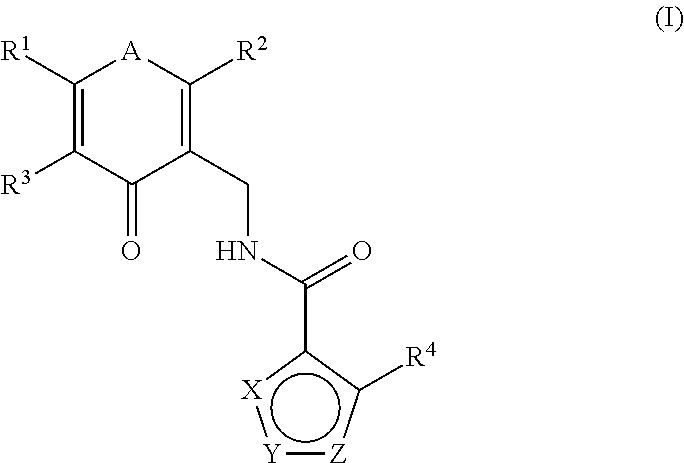Enhancer of zeste homolog 2 inhibitors
a zeste homolog 2 inhibitor and zeste technology, applied in the field of compounds, can solve the problems of increased metastasis, shorter disease-free survival, and increased risk of recurren
- Summary
- Abstract
- Description
- Claims
- Application Information
AI Technical Summary
Benefits of technology
Problems solved by technology
Method used
Image
Examples
example 1
[0297]N-((2,6-dimethyl-4-oxo-1,4-dihydropyridin-3-yl)methyl)-5-(ethyl(tetrahydro-2H-pyran-4-yl)amino)-4-methylthiophene-3-carboxamide
a) Methyl 5-(ethyl(tetrahydro-2H-pyran-4-yl)amino)-4-methylthiophene-3-carboxylate
[0298]To a solution of commercially available methyl 5-amino-4-methylthiophene-3-carboxylate (500 mg, 2.92 mmol) in DCE (10 mL) were added acetic acid (0.334 mL, 5.84 mmol) and dihydro-2H-pyran-4(3H)-one (322 mg, 3.21 mmol). The reaction was maintained at room temperature for 20 min, at which time NaBH(OAc)3 (2476 mg, 11.68 mmol) was added portion wise. The reaction was stirred for 90 min. LCMS showed the reaction was complete. To the reaction mixture was added acetaldehyde (0.198 mL, 3.50 mmol) and NaBH(OAc)3 (˜500 mg). The reaction was stirred for 1 h, at which time it was quenched with sat. NaHCO3, extracted with DCM, and concentrated. The residue was purified by silica gel chromatography (Varian 971IF, 0-50% EtOAc / hexanes, SF25-40g, 15 minutes) to give methyl 5-(ethyl...
example 2
[0301]N-((2,6-dimethyl-4-oxo-1,4-dihydropyridin-3-yl)methyl)-5-(((trans)-4-(dimethylamino)cyclohexyl)(ethyl)amino)-4-methylthiophene-3-carboxamide
a) Methyl 5 -(((cis)-4-(dimethyl amino)cyclohexyl)(ethyl)amino)-4-methylthi ophene-3-carboxylate and Methyl 5-(((trans)-4-(dimethyl amino)cy cl ohexyl)(ethyl)amino)-4-methylthiophene-3-carboxylate
[0302]To a solution of methyl 5-amino-4-methylthiophene-3-carboxylate (800 mg, 4.67 mmol) in DCE (25 mL) were added acetic acid (0.535 mL, 9.34 mmol) and 4-(dimethylamino)cyclohexanone (660 mg, 4.67 mmol). The reaction was maintained at room temperature for 40 min, at which time NaBH(OAc)3 (3961 mg, 18.69 mmol) was added portion-wise. The mixture was stirred at room temperature for 30 min, at which time acetaldehyde (0.317 mL, 5.61 mmol) and more NaBH(OAc)3 (990 mg, 4.67 mmol) were added. The reaction was stirred for 1 h, at which time it was quenched with NaHCO3, extracted with DCM, and concentrated. The crude residue was purified by reverse phas...
example 3
[0308]N-((5-amino-2,6-dimethyl-4-oxo-1,4-dihydropyridin-3-yl)methyl)-5-(((trans)-4-(dimethylamino)cyclohexyl)(ethyl)amino)-4-methylthiophene-3-carboxamide
[0309]To a solution of 5-(((trans)-4-(dimethylamino)cyclohexyl)(ethyl)amino)-4-methylthiophene-3-carboxylic acid (170 mg, 0.274 mmol) in DMSO (3 mL) were added 3-amino-5-(aminomethyl)-2,6-dimethylpyridin-4(1H)-one bis-hydrochloride (79 mg, 0.324 mmol), HOAt (45 mg, 0.329 mmol), and EDC (63 mg, 0.329 mmol), followed by NMIVI (2.196 mL, 19.97 mmol). The reaction was stirred at ambient temperature for 2 h, at which time water (2 mL) was added and the reaction was allowed to stand overnight. The reaction was purified directly by prep HPLC (Gilson; Gradient of B: 8-45%, A: water+0.1% TFA, B: CH3CN+0.1% TFA). The resulting residue was dissolved in MeOH / DCM and TEA (0.3 ml), adsorbed onto silica gel, and purified by column chromatography (4 g silica column; Gradient of B: 25-100%, A: DCM, B: 90 / 10 / 1 of CHCl3 / MeOH / NH4OH). The residue solid...
PUM
| Property | Measurement | Unit |
|---|---|---|
| weight | aaaaa | aaaaa |
| weight | aaaaa | aaaaa |
| weight | aaaaa | aaaaa |
Abstract
Description
Claims
Application Information
 Login to View More
Login to View More - R&D
- Intellectual Property
- Life Sciences
- Materials
- Tech Scout
- Unparalleled Data Quality
- Higher Quality Content
- 60% Fewer Hallucinations
Browse by: Latest US Patents, China's latest patents, Technical Efficacy Thesaurus, Application Domain, Technology Topic, Popular Technical Reports.
© 2025 PatSnap. All rights reserved.Legal|Privacy policy|Modern Slavery Act Transparency Statement|Sitemap|About US| Contact US: help@patsnap.com



